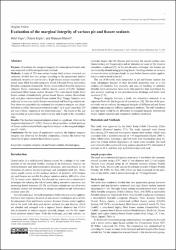Evaluation of the marginal integrity of various pit and fissure sealants
Citation
Yaşa B, Erçin Ö, Hatırlı H. Evaluation of the marginal integrity of various pit and fissure sealants. Journal of Oral Science (2023). 65(4); 209-213.Abstract
Purpose: To evaluate the marginal integrity of various pit and fissure seal ants subjected to different application methods.
Methods: A total of 253 non-carious human third molars extracted and
randomly divided into two groups according to the preparation method
employed: invasive or non-invasive. Eight fissure sealant materials were
tested: nano-filled flowable composite (Filtek Ultimate Flow), nanohybrid
flowable composite (GrandioSo Flow), micro-hybrid flowable composite
(Majesty Flow), resin-based unfilled fissure sealant (ClinPro Sealant),
resin-based filled fissure sealant (Fissurit FX), resin-based highly filled
fissure sealant (GrandioSeal), giomer-based fissure sealant (BeautiSeal ant), and glass ionomer-based fissure sealant (Fuji Triage). Samples were
subjected to two-year cyclic thermo-mechanical and brushing simulations.
Two observers quantitatively evaluated the restoration margins and classi fied them as either “permanent restoration edge”, or if a gap larger than 250
μm was evident, “gapping at the restoration edge”. The extent of the gap
was recorded as a percentage relative to the total length of the restoration
edge.
Results: The baseline marginal adaptation had no significant effect on the
marginal adaptation (P > 0.05). However, the preparation method and type
of fissure sealant material had a significant impact on the marginal adapta tion (P < 0.05).
Conclusion: On the basis of quantitative analysis, the highest marginal
integrity was observed for flowable composites, whereas the lowest was
observed for glass ionomer-based fissure sealant.
Source
Journal of Oral ScienceVolume
65Issue
4URI
https://www.jstage.jst.go.jp/article/josnusd/advpub/0/advpub_23-0126/_pdfhttps://doi.org/10.2334/josnusd.23-0126
https://hdl.handle.net/20.500.12780/740


















